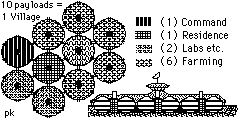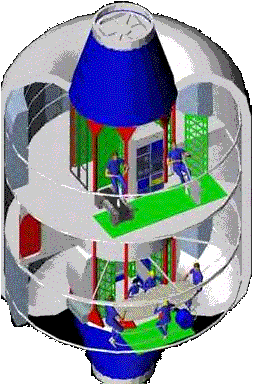Inflatables and other Big Dumb Volume Options for Habitats on the Moon and Mars
by Peter Kokh
I presented a paper entitled:
THE LUNAR "HOSTEL": An Alternate Concept for First Beachhead and Secondary Outposts
at the 1991 International Space development Conference in San Antonnio. Three concepts from this paper have found their way into mainstream NASA thinking. There has been no attribution to me, but that is fine. I did not have the expertise to carry the basic ideas further, and was thrilled and delighted to see one of them come to life and be validated in NASA's TransHab mockup in Houston, while on a visit in May 1999. This paper is not currently online and the original illustrations were hand drawn, so I do not have electronic copies.
However, a report on the application of the "donut" design was also published in an issue of "Harvest Moon" for an article about agricultural applications of the concept. You can click to this article and its illustrations here. Note, the article entitled "Moonbagel" is the 2nd one on this page.
The idea was an answer to the exercise of finding a way to pack larger habitat structures into the set-size space shuttle payload bay.
The illustrations alone are copied below:
You will Note from the profile that such a structure might be ideal for siting in a properly sized crater as that would minimize excavation.
Here is an example of how such structures could be "ganged" into large complexes:
Bob Zubrin has been very interested in NASA's TransHab version, originally brainstormed as an add on habitat module for the International Space Station. Bob saw it at once as a faster, better, cheaper MarsHab both for the crew in transit and for use on Mars itself.
Note that in NASA's version, designed for unshielded use in open space, the inflatable envelope wall is a foot thick and many-layered to provide micrometeorite protection. This would not be necessary for a surface version which is to be promptly covered with regolith shielding. The thick wall of the NASA version is the reason for the relatively small size of TransHab. With a thinner wall designed to hold pressure only, the size of the inflatable torus can be quite a bit larger.
Page 1: Visual and Solar Access
Page 4: Ideas for a Moon / Mars habitat Demo





